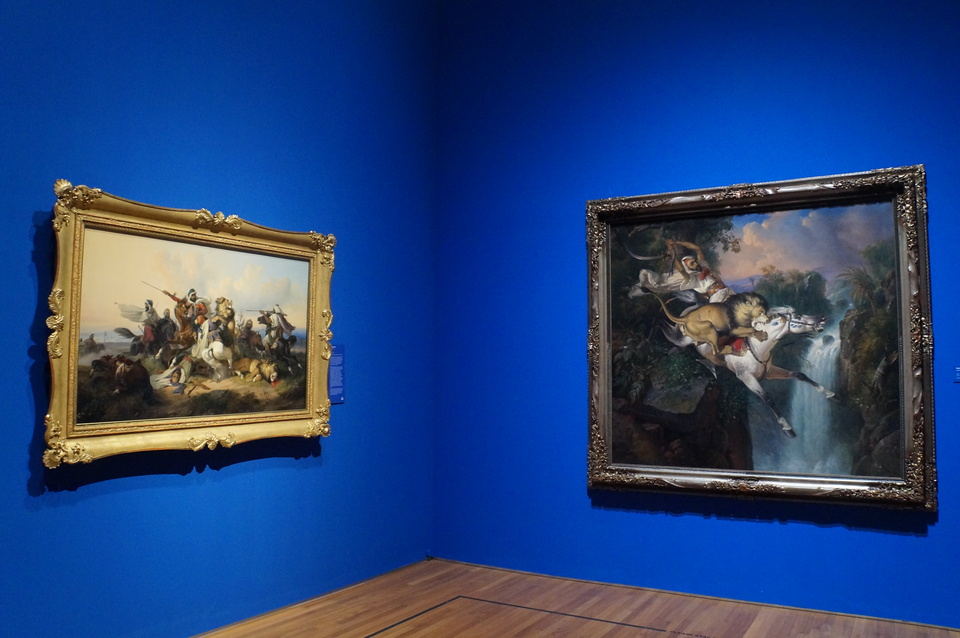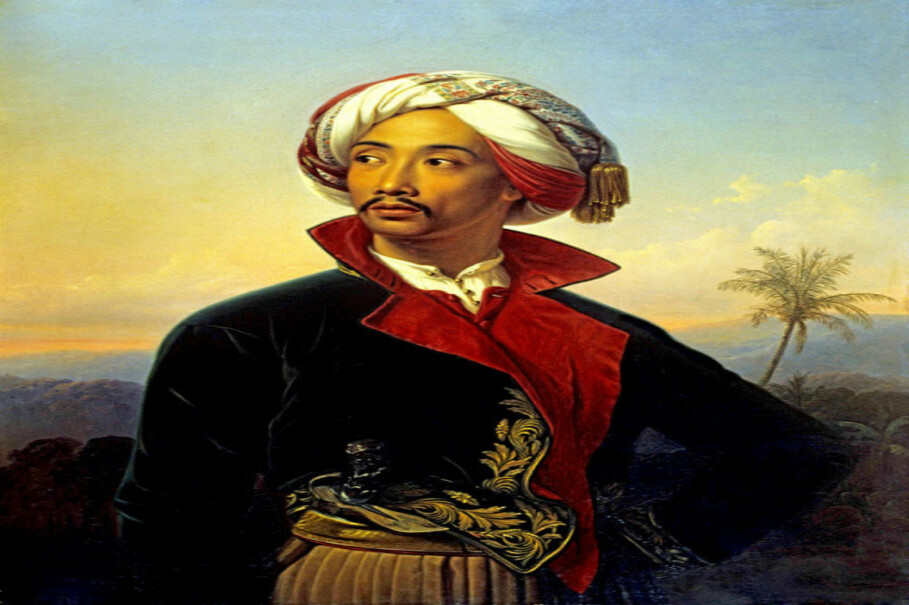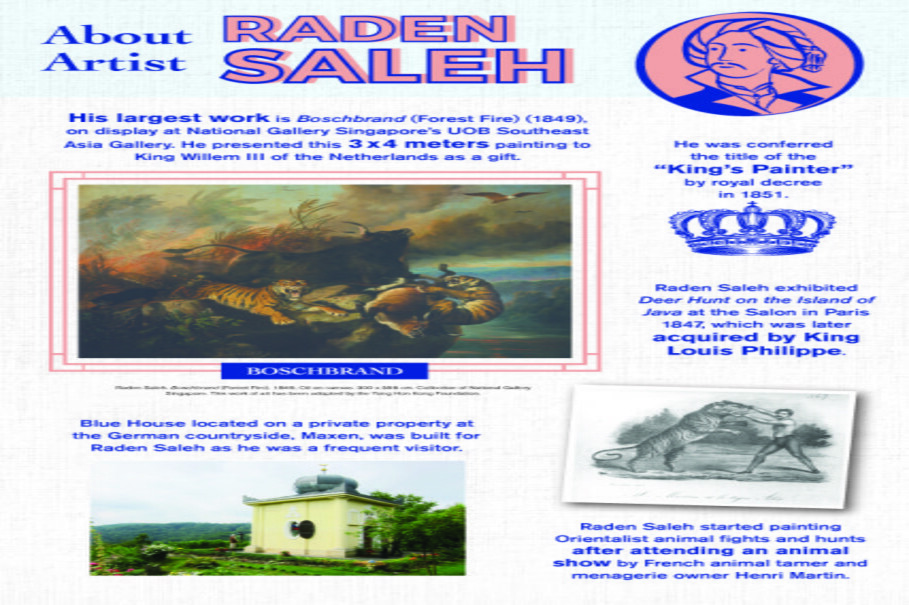Life of Raden Saleh, Artist of Two Worlds

Jakarta. In late January, French auctioneer Jack-Philippe Ruellan told the Jakarta Globe he had just sold Raden Saleh’s painting, "The Banteng Hunt," (The Bull Hunt) for €7.2 million ($8.9 million), which he claimed was "a record for Raden Saleh and Indonesian paintings in general."
The winning bid came from an Indonesian collector who wanted to remain anonymous.
The Banteng Hunt, dated 1855, had lain neglected in a house in Brittany in the western part of France for many years.
A man claiming to be the owner of the painting visited Ruellan’s office in August last year with pictures of the long-lost painting.
Ruellan sent a team of curators to the man's house in Auray, where the painting was kept in the cellar since he inherited it from his great aunt.
"The man didn't know the painting was made by a master, and completely neglected it. He did not like the painting, and nobody in the family wanted it either, so they kept it covered in a cellar under wraps since the '90s," Ruellan said.
Ruellan himself did not know who Raden Saleh was until his team checked their database, but after the auction proved to be a great success, it is safe to say he is now more than well acquainted with the artist.
"Raden Saleh's paintings were quite fashionable in Paris when during his time there. He was inspired by Delacroix and worked for a time with Horace Vernet. He also painted for King Louis-Philippe and Napoleon III. Then everyone sort of forgot about him... But he's now been rediscovered," Ruellan said.
A Privileged Prodigy
Raden Saleh Syarif Bustaman was born in 1811 in Semarang, Central Java, to an upper-class Javanese family. His uncle was the Semarang regent, Kyai Adipati Sura Adimanggala.
The little Javanese prince grew up in a privileged household and was friends with sons and daughters of Dutch officers and traders in the city.
When he was still a young boy, Raden Saleh met a Belgian landscape painter called Antoine Auguste Joseph Payen, who was sent to Java to travel and document "mooi indie" Javanese landscapes.
According to Syed Muhammad Hafiz, assistant curator of the "Between Worlds: Raden Saleh and Juan Luna" exhibition showing at National Gallery Singapore until March 11, Raden Saleh followed Payen around Java from 1819, when he was only eight.
At such a young age, the boy reportedly already showed a great talent for drawing.
Payen, Raden Saleh’s first acknowledged mentor, returned to Europe in 1826.
In 1829, the Javanese prince was offered a chance to go to Europe with a Dutch colonial officer called Jean Baptiste De Linge.
"It wasn’t as if he had this plan, 'I want to become an artist. I want to go to Europe.' It was the luck of the draw. Of course the Dutch knew [Raden Saleh] was an intelligent guy. He could draw. He travelled with Payen. Then it just so happened that [De Linge] was going back to the Netherlands and he needed a secretary," Hafiz told the Jakarta Globe.
Growing Up in Europe
Raden Saleh stayed at The Hague with the family of Jean Chrétien Baud, a former Dutch East Indies governor general.
Baud took care of the young aristocrat and introduced him to influential people, including artists.
He was given allowances and his education was paid for by the Dutch government.
At that time, Raden Saleh painted mostly landscapes, seascapes and portraits of powerful figures, including three former governors general of the Dutch East Indies, Baud being one of them.
"Raden Saleh got quite a reputation because he could paint as well as the Europeans. He had the skills, the technique. But he wanted more. He was very ambitious. He wanted to be at the top," Hafiz said.
Historical paintings were all the rage back then, but Raden Saleh could not get into the style. He found another genre, one that will eventually elevate his status to be the equal of his European peers: drawing animals.
Back then animal circus shows were extremely popular. Whenever famous animal tamer Henri Matin visited a town, people would flock to his show, including Raden Saleh.
He would come to the circus and try to paint the lions in their cages as realistically as possible.
"He even painted a portrait of Henri Matin so he could go backstage and see the lions up close," Hafiz said.
This was around the time Raden Saleh painted his "Wounded Lion" (dated 1838), which marked the beginning of his Orientalist phase.
Raden Saleh moved to Germany and stayed there for five years, mostly in Dresden and Coburg.
When he arrived in Dresden in 1839, the Romantic art movement, and particularly the Orientalist trend, was at its peak.
In 1841, one of Raden Saleh's masterpieces, "Lion Hunt," "caused a sensation at the Dresden academy’s annual exhibitions and generated numerous orders," according to the book "On the Importance of Raden Saleh’s Dresden Years for His Art" by Werner Kraus.
"Paintings of Oriental scenes really caught the European imagination. Raden Saleh knew that an Oriental like himself painting the orient was, I wouldn’t say a gimmick, but a selling point. This was when he started painting even more dynamic scenes like hunters killing each other, all these life or death scenes. They were all very dramatic," Hafiz said.
Raden Saleh continued with his orient-themed paintings when he moved to Paris, encouraged by his new mentor, Horace Vernet.
In Paris, exhibiting at the city's Salon was every painter’s dream, and Raden Saleh fulfilled it when his "Deer Hunt on the Island of Java" was shown in 1847 at the Salon Carré.
Later that year, he gifted the painting and his largest work, "Forest Fire," to King Willem III of the Netherlands.
In 1848, the king bestowed on the Javanese prince the title of "Schilder des Konings" (the King’s Painter).
With that, Raden Saleh’s ambition to see his paintings in the royal collection and gain the trust and recognition of European royalties had come true.
Triumphant Return
The prince arrived back in his homeland in February 1852. He hit the ground running and traveled a lot around Central Java, West Java (especially Buitenzorg, modern-day Bogor) and Batavia to spend time with his relatives and work on commissioned paintings of local figureheads and Dutch officers.
His prestigious title, the "King’s Painter," earned him a lot of respect among colonial officers in Java.
"He was still painting more or less the same type of society, the same type of people – the sultan of Pontianak [Syarif Hamid Alkadrie], the expats and, of course, he painted a lot of landscapes. His landscapes, in style and technique, had surpassed even those of Payen, his first teacher," Hafiz said.
Raden Saleh's landscape painting expertise also proved to be lucrative. In late 1850s, Scottish businessman Alexander Fraser commissioned him to paint four landscapes of Java.
One of them was "Javanese Temple in Ruins," which depicted the then recently excavated Mendut Temple.
According to Russel Storer, Raden Saleh was paid 1,000 guilders for each painting, a generous amount compared to his yearly allowance of 2,400 guilders from the Dutch government.
Other landscape works by Raden Saleh from this phase of his career included "Megamendung Pass," "Mail Station at the Bottom of Megamendung," and "View of Dieng Plateau."
This was also around the time he painted his famous "The Arrest of Pangeran Diponegoro," a proto-nationalist work that art historians say is a thinly veiled criticism of Nicolaas Pieneman’s earlier "Subjugation of Diponegoro."
In 1867, Raden Saleh tied the knot with another blue-blood, Raden Ayu Danudirejo, and settled in Buitenzorg.
This "first modern Indonesian man" passed away in 1880 and was buried in Bondongan, Bogor.
His grave is still there and a sprinkle of his fans still come to pay respect.
His house in Jakarta, which he designed and built himself in 1859, is also still standing. It is now used as an office of the PGI Cikini Hospital in Central Jakarta.
Tags: Keywords:POPULAR READS
Nissan to Make Next-Generation EV Batteries by Early 2029
Solid-state batteries are widely seen as the next step for EVs.Airlangga Set to Extend Leadership in Golkar After Election Success
Under his leadership, Golkar rose to the second position in the legislative polls and successfully made Gibran the elected vice president.Yellen Says Iran's Actions Could Cause Global 'Economic Spillovers'
Iran's missile attack on Israel early Sunday came in response to what it says was an Israeli strike on Iran's consulate in Syria.Takeaways from Prabowo's Responses to Legal Motion Contesting His Election Win
Part of the argument addresses the claim that the candidacy of Gibran Rakabuming Raka, Prabowo’s running mate, is unlawful.Prabowo Camp Cites ‘Procedural Error’ in Legal Challenge by Rival Candidates
The Constitutional Court's main task is to address alleged discrepancies in vote tallies, which neither of the plaintiffs challenged.Popular Tag
Most Popular


























